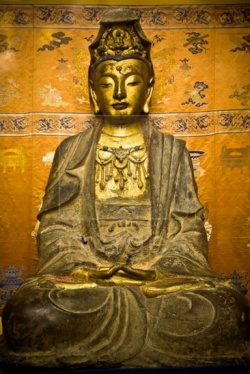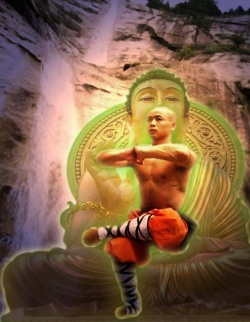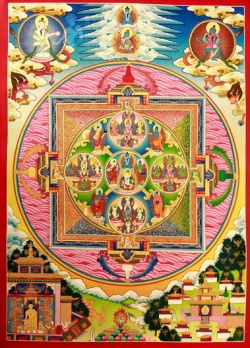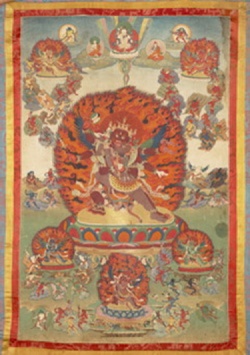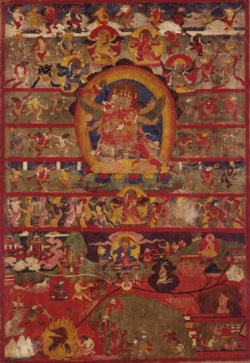Tibetan Book of the Dead
The Tibetan Book of the Dead was first translated into English in 1927. Its title was coined by its translator, the American scholar W. Y. Evans-Wentz, in imitation of the famous (and equally mistitled) Egyptian Book of the Dead.
The actual name of the text is Bardo Tödrol Chenmo (བར་དོ་ཐོས་གྲོལ་ཆེན་མོ་, Wyl. bar do thos grol chen mo), which means "The Great Liberation through Hearing in the Bardo",
a terma discovered by Karma Lingpa at the age of fifteen on top of a mountain in Tibet.[1]
Sogyal Rinpoche writes in the Tibetan Book of Living and Dying:
These teachings have a lineage stretching back beyond human masters to the Primordial Buddha (Skt. Samantabhadra, Tib. Kuntuzangpo),
who represents the absolute, naked, sky-like primordial purity of the nature of our mind.
But the Bardo Tödrol Chenmo itself is part of one large cycle of teachings [i.e. the Zabchö Shitro Gongpa Rangdrol] handed down by the master Padmasambhava and revealed in the fourteenth century by the Tibetan visionary Karma Lingpa.
- The Great Liberation through Hearing in the Bardo is a unique book of knowledge.
It is a kind of guidebook or a travelogue of the after-death states, which is designed to be read by a master or spiritual friend to a person as the person dies, and after death.
In Tibet there are said to be "Five Methods for Attaining Enlightenment without Meditation": on seeing a great master or sacred object;
on wearing specially blessed drawings of mandalas with sacred mantras (Tib. takdrol);
on tasting sacred nectars, consecrated by the masters through special intensive practice; on remembering the transference of consciousness, the phowa, at the moment of death; and on hearing certain profound teachings, such as the Great Liberation through Hearing in the Bardo.
- The Tibetan Book of the Dead is destined for a practitioner or someone who is familiar with its teachings.
For a modern reader it is extremely difficult to penetrate, and raises a lot of questions that simply cannot be answered without some knowledge of the tradition that gave birth to it.
This is especially the case since the book cannot be fully understood and used without knowing the unwritten oral instructions that a master transmits to a disciple, and which are the key to its practice.
- In this book [The Tibetan Book of Living and Dying], then, I am setting the teachings, which the West has become familiar with through the Tibetan Book of the Dead, in a very much larger and more comprehensive context.
English Translations
- W. Y. Evans-Wentz, Tibetan Book of the Dead (London: Oxford University Press, first edition 1927)
- Francesca Fremantle and Chögyam Trungpa, Tibetan Book of the Dead (Boston: Shambhala, first edition 1975)
- Gyurme Dorje and Edited by Graham Coleman with Thubten Jinpa, The Tibetan Book of the Dead (Penguin: 1993)
- Robert Thurman, The Tibetan Book of the Dead (Bantam Books, Inc.: 1994)
- The first ever complete and unabridged translation, by Gyurme Dorje and edited by Graham Coleman with Thubten Jinpa, The Tibetan Book of the Dead (Penguin: 2006)
Further Reading
- Bryan Cuevas, The Hidden History of the Tibetan Book of the Dead, Oxford University Press, 2003.
- Donald S. Lopez Jr., Prisoners of Shangri-La—Tibetan Buddhism and the West, (The University of Chicago Press, 1998), Ch. 2 'The Book'.
- Padmasambhava, Le Livre des morts tibétain , complete and unabridged translation by Philippe Cornu (ed. & transl.) (Paris: Buchet-Chastel, 2009).
- Sogyal Rinpoche, The Tibetan Book of Living and Dying (HarpersSanFrancisco: 1992).
Footnotes
- ↑ W. Y. Evans-Wentz, Tibetan Book of the Dead (London: Oxford University Press, first edition 1927, Foreword)
Source
RigpaWiki:Tibetan Book of the Dead
Since its first English translation in 1927, the Tibetan guide to spiritual and mental liberation called the Bardo Thodol has been known in the West as the Tibetan Book of the Dead.
The book has reappeared in several English-language versions since then, some based only loosely on the original.
The text has thus lived several lives in English alone, appearing to be reborn time and again before new audiences, often with varying titles and content. Yet these recent lives are part of a much older cycle of rebirths.
The original is believed to have been composed in the eighth century C.E. by the great master Padma Sambhava, then hidden away by its author for the salvation of future generations.
The text was rediscovered six centuries later by Karma Lingpa, believed by some to be an incarnation of Padma Sambhava himself.
Since the fourteenth century C.E. the text has occupied a central place in Tibetan Buddhism, giving birth to a large number of parallel, supplementary, and derivative texts.
W. Y. Evans-Wentz coined the English title for the 1927 edition on the basis of analogies he perceived with the Egyptian funerary text The Book of Coming Forth By Day, known in the West as the Egyptian Book of the Dead.
Both the Tibetan and Egyptian Books discuss death and its aftermath. Yet their views of death are sufficiently different from the Judeo-Christian tradition that the English titles are quite misleading.
This is particularly so in the case of the Tibetan Book of the Dead.
The Tibetan title, Bardo Thodol, does not refer to death as such.
Thodol means "liberation through understanding."
Bardo means a "between state," an interval or transition between two mental states, whether experienced in life or after death.
Hence the work's Tibetan title (which might be translated more literally as Liberation through Understanding the Between ) alludes to bardo states that may be experienced at any point over the cycle of life, death and rebirth, yet the work itself overtly discusses only the bardo states experienced during death, offering explicit instruction on how to navigate them.
It is difficult to appreciate the significance of the work's overt content without a sense of its larger cultural context.
The Bardo Thodol presupposes a cosmology of human experience in which existence is viewed as inherently fluid and impermanent, as involving a series of stages, of which death is merely one.
The mind or soul continues to live after death, undergoing a series of experiences before rebirth.
Human beings are believed to be able to guide themselves through the entire cycle by creating a more focused self-awareness through their powers of concentration, ideally, by means of meditation.
The chief utility of meditation during life, or of the Bardo Thodol at the time of dying, lies in making the mind lucid enough to control its own passage over the cycle of life, death, and rebirth.
The larger goal of these practices is to seek liberation from the suffering associated with this cycle, both for oneself and for others.
The Bardo States
Six main bardo experiences are distinguished in Tibetan Buddhism:
Three are encountered during life and
three are encountered after death.
A single life span is itself a bardo state, a transitional zone in a larger cycle of rebirths.
Dreams are bardo states that occur within the daily round, in the interval between falling asleep and waking; feelings of uncertainty, paranoia, and delusion are sometimes grouped with dreams on a looser interpretation of this second bardo state.
A meditative trance is a third type of bardo state, an intermediate zone between ordinary consciousness and enlightened awareness. These are the main bardo states of life.
Death involves bardo states as well.
On the Tibetan view, death is not an instantaneous event but a process taking several days, involving a successive dissociation of mind from body, which is manifested in characteristic outward signs.
During this process, the conscious mind experiences three main bardo states.
The first of these, called the Chikai Bardo, is the experience of the death point, the moment at which the soul loses consciousness of objects and becomes aware only of itself.
The experience is described as a vivid formless light emanating from all sides.
At this moment, enlightenment lies close at hand, although one's capacity to attain it depends on the extent to which one has achieved lucidity and detachment in one's previous existence.
For most individuals the vision of light can only be sustained for a brief interval, after which the soul, caught in desire and delusion, regresses toward lower levels of existence.
In the second state, called the Chonyid Bardo, the soul has visions involving a succession of deities: a series of beatific Buddhas in the first seven days, a series of terrifying deities in the next seven.
The text describes these visions as projections of the mind's own consciousness, often involving a tension within the mind itself.
For example, the dazzling visions of the beatific deities are accompanied by duller visions of other beings that distract from the splendor of the former.
To be thus distracted is to give in to anger, terror, pride, egotism, jealousy, and other weaknesses.
In contrast, to ignore the minor visions and to embrace the more awe-inspiring deities is to attain spiritual salvation through the very act.
A mind that fails to overcome these weaknesses encounters the darker, more horrific deities of the latter seven days.
Many of these visions are merely aspects of the Buddhas encountered in the first seven days, now made terrifying by the mind's own weakness.
Liberation is still possible here simply by recognizing these beings for who they are.
Yet the act is also more difficult now because terror forces the mind to flee rather than to examine its experiences.
A mind that has failed to free itself by this point enters the Sidpa Bardo, the third, most desperate stage.
Here the mind faces a host of hallucinations, including visions of pursuit by demons and furies, of being devoured and hacked to pieces.
A mind may linger here for many weeks—up to the forty-ninth day after death—depending on the faculties of the particular individual.
These experiences culminate in rebirth in some sentient form.
Whether one is reborn as human or animal, or is relegated for a time to one of the many Tibetan hells,
or whether one achieves liberation from the entire cycle of life and rebirth, thus attaining Buddahood, depends on one's success in overcoming weakness over the course of the cycle.
Although the Bardo Thodol is a guide to the bardo states experienced after death, it can only be read by the living.
It may be read in preparation for one's own death, or at the deathbed of another.
Because the weaknesses attributed to the dead are all experienced by the living as well, a person learning to traverse the bardo states of death will learn to navigate better the bardo experiences of life as well.
In this sense the book is a guide to liberation across the entire cycle of human existence as conceived in Tibetan Buddhism.
See also: Dying, Process of ; Egyptian Book of the Dead ; Moment of Death ; Stage Theory
Bibliography
Evans-Wentz, W. Y., ed. The Tibetan Book of the Dead, or he After-Death Experiences on the Bardo Plane, according to Lama Kazi Dawa-Samdup's English Rendering. 1927. Reprint, Oxford: Oxford University Press, 2000.
Fremantle, Francesca, and Chögyam Trungpa. The Tibetan Book of the Dead: The Great Liberation Through Hearing in the Bardo, by Guru Rinpoche according to Karma Lingpa. Berkeley, CA: Shambala Press, 1975.
Lauf, Detlef Ingo. Secret Doctrines of the Tibetan Books of the Dead. Boulder, CO: Shambala Press, 1977.
Leary, Timothy, Ralph Metzner, and Richard Alpert. The Psychedelic Experience: A Manual Based on the Tibetan Book of the Dead. Secaucus, NJ: The Citadel Press, 1976.
Rabjam, Longchen. The Practice of Dzogchen, edited by Harold Talbott and translated by Tulku Thondup. Ithaca, NY: Snow Lion Publications, 1996.
Rinbochay, Lati, and Jeffrey Hopkins. Death, Intermediate State and Rebirth in Tibetan Buddhism. Valois, NY: Snow Lion Publications, 1979.
Rinpoche, Sogyal. The Tibetan Book of the Living and Dying. San Francisco: Harper, 1992.
Thurman, Robert, tr. The Tibetan Book of the Dead: Liberation through Understanding in the Between, with a foreword by the Dalai Lama. New York: Bantam Books, 1994.
